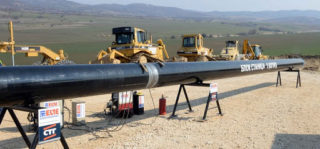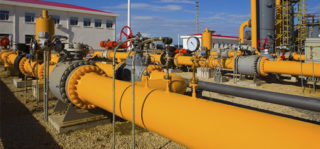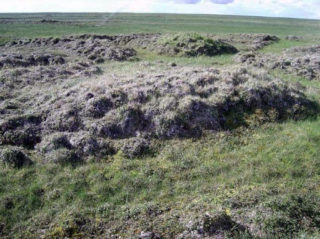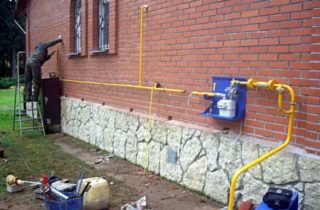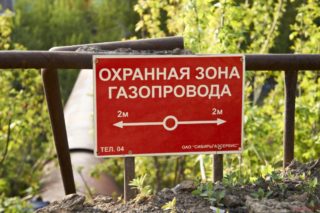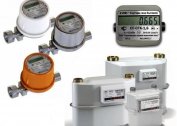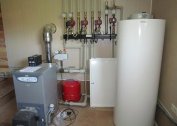On the way of transporting energy from the place of their extraction to the final consumer, a communication system is installed, one of the components of which is an elevated gas pipeline. Considering the danger of the substance passing through it, for the greater extent the route is buried in the ground, where it is protected from the influence of most external factors. However, in some cases, engineers are forced to let the pipeline through the air. Such a solution has a scientific basis and mathematically verified implementation mechanisms.
General piping rules
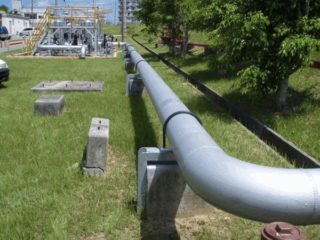
An overhead gas pipeline is a surface fuel transportation system consisting of pipes, fittings, supports, special equipment, lighting and ventilation devices. The design is located above the earth's surface and is equipped in accordance with SNiP 42-01-02 and SNiP 3.05.02-88.
According to the standards prescribed in these documents, the construction of ground structures is allowed in such places:
- the mountains;
- Deserts
- swamps;
- territory with unstable soil;
- eternal Frost;
- natural and artificial obstacles.
This engineering decision is made in exceptional cases when the risks of underground installation are higher than air. At the same time, effective measures are taken to ensure the safe and reliable operation of the highway.
The basic rules for planning and building gas pipelines are to protect them from such factors:
- electromagnetic pulse;
- mechanical impact;
- heat;
- open flame.
In accordance with regulatory enactments, the overhead line must be installed on a stable and non-combustible basis.
Features of the overhead gas pipeline
The laying of the trunk is allowed to be performed on such a basis:
- freestanding pillars, columns and supports;
- overpasses over which high voltage cables do not pass;
- blank walls of residential, administrative and public buildings.
The surface and transit laying of the gas pipeline through the premises for entertainment and educational purposes is prohibited.
The basis material can be concrete, metal, brick and wood objects covered with fireproof finish. To collect condensate, siphons are arranged, consisting of a tank and a lid with a valve through which liquid is pumped out. Siphons, shutoff and control valves are illuminated in the dark.
Stages of gas pipeline transit
When there are buildings on the gas pipeline path, an engineering decision is made on the transit laying through a facade or a high strip foundation, depending on the structure of the structure.
The procedure consists of the following steps:
- Training. Calculations are carried out, design documentation is prepared. The wall is cleaned of external decoration, a hole of the desired diameter is made in it.
- Installation. A sleeve is inserted into the hole made. A horizontal determination is made and at its level, the near and subsequent supports are installed. A pipe is passed through the building and removed from it in a similar way. When entering a gas pipeline into a building, the requirements of SNiP are observed at each phase of the installation.
- Control and acceptance of work.Commission inspection of system tightness, completeness and correct installation of instruments and equipment. Measurements are also taken regarding the normalized distances from heating, electrical devices and water supply systems.
The changes made are displayed in the technical passport of the house.
Factors affecting the installation of a gas pipeline in a section
When planning the laying of a gas pipeline in a section, all objective and subjective factors are taken into account.
The following circumstances affect the choice of installation method:
- Type of soil. In heaving, mobile and rocky installation of underground pipelines is prohibited.
- The presence on the site of underground utilities crossing the gas pipeline. This may make trenching impossible.
- Growing ornamental crops or structures that cannot be dismantled or moved.
The presence of such factors becomes the reason for the installation of the gas pipeline above the ground.
Distances between elevated gas pipelines and other pipelines
Blue fuel is a hazardous substance that can ignite from heat and sparks. Based on this, special requirements are imposed on the laying of pipes for its transportation.
Minimum distance from the gas pipeline to other utilities:
- heating - 15 cm;
- Sewerage - 15 cm;
- water supply - 15 cm;
- telephone cable - 50 cm;
- power cable - 50 cm.
In places where people move, the height of the pipeline must be at least 220 cm, above roads - 500 cm. In uninhabited places or in protected areas, the pipeline is laid on supports with a height of 35 cm.
The intersection of the gas pipeline with the water supply
If during the installation the gas pipeline intersected with the water supply system, inclined sections are made on the blue fuel route, in the lower parts of which siphons are installed to collect condensate. An obligatory requirement is the upper location of the gas pipeline. At the same time, the vertical clearance between communications should be at least 25 cm.
The list of bans of the security zone
The purpose of creating a protective zone along the surface gas pipeline is to create conditions for its safe operation. It is created at a distance of 200 cm on both sides of the axis of the pipeline and is marked with clearly visible warning signs.
Within the security zone is prohibited:
- conduct construction;
- demolish pointers;
- interfere with the operation of installed devices;
- arrange garbage bins, drain chemically and biologically active liquids;
- to store building materials and equipment;
- burn waste and make bonfires;
- to carry out activities associated with a large crowd of people.
For violation of these rules, administrative, material and even criminal liability is imposed.
After the installation of the overhead gas pipeline is completed, it is tested for strength, density and throughput. All this is done when the highway is finally fixed to the supports. Then the structure is covered with oil paint, marking and numbering is applied to devices and mechanisms. Then the security zone is designated and the act of putting the object into operation is drawn up.
